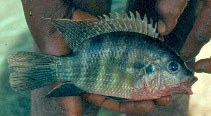| Family: |
Cichlidae (Cichlids), subfamily: Pseudocrenilabrinae |
| Max. size: |
22.84 cm TL (male/unsexed) |
| Environment: |
demersal; freshwater |
| Distribution: |
Africa: in coastal rivers (Ref. 52307) from the upper Casamance River in Senegal up to the St. John River in Liberia (Ref. 53405). |
| Diagnosis: |
Dorsal spines (total): 13-15; Dorsal soft rays (total): 11-13; Anal spines: 3-3; Anal soft rays: 8-9. Description: body moderately deep (Ref. 52307, 53405) and compressed (Ref. 53405). Head and mouth large (Ref. 52307). Snout rounded, its dorsal profile straight or slightly convex; outer and inner jaw teeth monocuspid, pharyngeal jaw teeth bicuspid; 3 scale rows on cheeks; micro-gillrakers present; scales cycloid (Ref. 53405). Caudal fin slightly rounded (Ref. 52307).
Coloration: in life: light to dark brown on back, light brown on sides; belly orange-brown, throat somewhat lighter, both fins reddish during the reproduction period (Ref. 53405). Sides with 5-6 faint cross bars (Ref. 52307, 53405) depending on behavioural state (Ref. 52307). Dorsal fin orange anteriorly, lighter posteriorly, with dark orange fringe and whitish submarginal band; caudal fin light, with narrow, white fringe and narrow, light orange submarginal band; pelvics and anal fin yellow-orange; pectorals hyaline (Ref. 53405). Some body scales with iridescent margins; red and blue dots and short bars often visible on caudal and soft dorsal and anal fins; relatively large "pelmatochromis"-spot present on dorsum in both juveniles and adults, often reaching onto dorsal fin in juveniles but in a lower position in adults (Ref. 52307). |
| Biology: |
Omnivorous, feeding on small items like detritus and insect larvae; probably an open substratum spawner (Ref. 52307). |
| IUCN Red List Status: |
Least Concern (LC); Date assessed: 16 October 2019 Ref. (130435)
|
| Threat to humans: |
harmless |
Source and more info: www.fishbase.org. For personal, classroom, and other internal use only. Not for publication.

